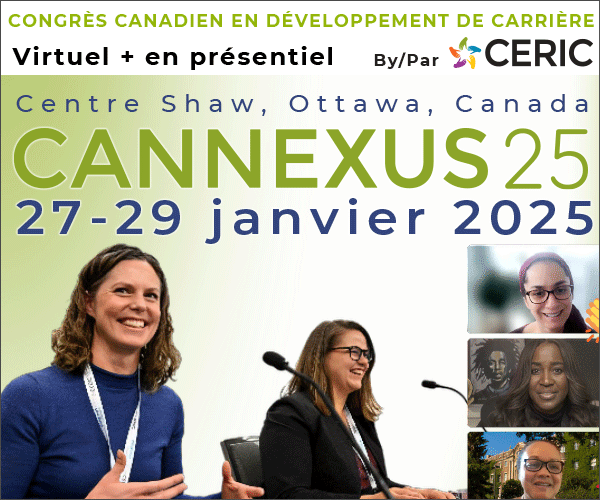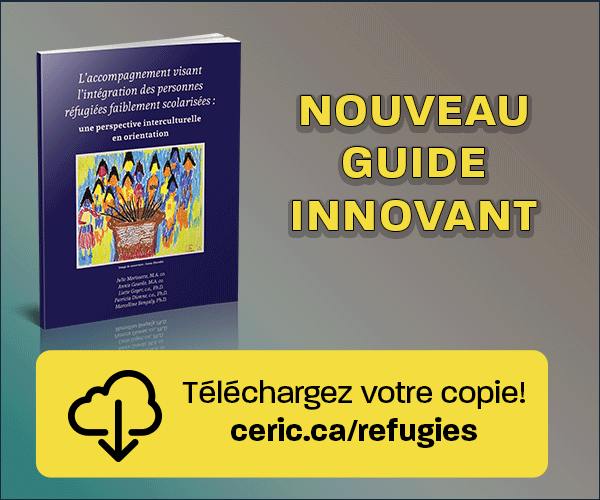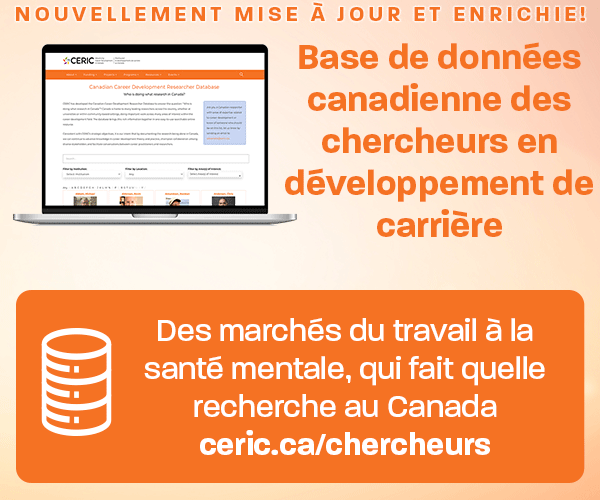Intégration de la formation au choix d’une carrière à l’école secondaire de premier cycle : les avantages, les défis et les recommandations
Mots-clés :
carrière, formation professionnelle, école secondaire de premier cycle, défis, éducation, intégrationRésumé
Les enseignants stagiaires en Alberta du Sud, Canada, ont complèter deux cours d’éducation de carrière pour les préparer à intégrer des projets d’éducation de carrière dans leurs cours d’école secondaire traditionnels. Cette recherche non expérimentale a utilisé l’analyse de contenu pour examiner l’efficacité de onze projets d’éducation de carrière et leurs interventions d’éducation de carrière correspondantes qui ont été mis en œuvre par onze enseignants stagiaires. Onze rapports de projet et 309 enquêtes d’évaluation des élèves ont été examinés pour déterminer les tendances de forces de projet, les défis et recommandations pour l’éducation de carrière. Recommandations pour la recherche et pratique (future) sont discutées.
Références
Bardick, A.D., Bernes, K.B., Magnusson, K.C., & Witko, K.D. (2006). Junior high students’ career plans for the future: A Canadian perspective. Journal of Career Development, 32, 250- 271. doi:10.1177/0894845305279168
Bardick, A.D., Bernes, K.B., Magnusson, K.C., & Witko, K.D. (2004). Junior high career planning: What students want. Canadian Journal of Counselling and Psychotherapy, 38, 104-117. Retrieved 8 May 2015 from http://cjc-rcc.ucalgary.ca/jc/index.php/rcc/article/view/249
Bernes, K., & Magnusson, K. (2004). Building future career development programs for adolescents. NATCON Papers 2004. Retrieved 8 May 2015 from http://contactpoint.ca/wpcontent/uploads/2013/01/pdf-04-11.pdf
Chen, C.P. (2005). Counsellor and teacher collaboration in classroom-based career guidance. Australian Journal of Career Development, 14, 18-28. doi:10.1177/103841620501400305
Dietsche, P. (2013). Career planning in Ontario grade 10 students: Counsellor perspectives. The Canadian Journal of Career Development, 12, 4-16. Retrieved
May 2015 from http://cjcdonline.ca/wp-content/uploads/2014/11/Career-Planning-in-Ontario-Grade-10-Students1.pdf
Elkind, D. (1968). Cognitive development in adolescence. In J.F. Adams (Ed.), Understanding adolescence. Boston, MA: Allyn & Bacon.
Elo, S., & Kyngas, H. (2008). The qualitative content analysis process. Journal of Advanced Nursing, 62, 107-115. doi:10.111/j.1365-2648.2007.04569.x
Forman, J., & Damschroder, L. (2008). Qualitative content analysis. In L. Jacoby, & Siminoff, L.A. (Eds.), Empirical methods for bioethics: A primer (pp. 39-62). San Diego, CA: JAI Press.
Garg, R., Kauppi, C., Urajnik, D., & Lewko, J. (2010). A longitudinal study of the effects of context and experience on the scientific career choices of Canadian adolescents. Canadian Journal of Career Development 9, 15-24. Retrieved 8 May 2015 from http://cjcdonline.ca/wp-content/uploads/2014/11/A-Longitudinal-Study-of-the-Effects-ofContext-and.pdf
Gibbons, M.M., Borders, L.D., Wiles, M.E., Stephan, J.B., & Davis, P.E. (2006). Career and college planning needs of ninth graders – as reported by ninth graders. Professional School Counseling, 10, 168-178. Retrieved 8 May 2015 from http://libres.uncg.edu/ir/uncg/f/L_Borders_Career_2006%20(MULTI%20UNCG%20AUTHORS).pdf
Herr, E.L., & Cramer, S.H. (1996). Career guidance and counseling through the lifespan (5th Ed). New York, NY: HarperCollins Publishers Inc.
Hiebert, B. (1993). Career education: A time for infusion. Guidance & Counselling, 8, 1-5.Kenny, M.E., & Bledsoe, M. (2005). Contributions of the relational context to career adaptability among urban adolescents. Journal of Vocational Behavior, 66, 257-272. doi:10.1016/j.jvb.2004.10.002
Kenny, M.E., Blustein, D.L., Haase, R.F., Jackson, J., & Perry, J.C. (2006). Setting the stage: Career development and the student engagement process. Journal of
Counseling Psychology, 53, 272-279. doi:10.1037/0022-0167.53.2.272
Kosine, N.R., Steger, M.F., & Duncan, S. (2008). Purpose-centered career development: A strengths-based approach to finding meaning and purpose in careers. Professional School Counseling, 12, 133-136. Retrieved 5 May 2015 from http://www.michaelfsteger.com/wp-content/uploads/ 2012/08/Kosine-Steger-Duncan-PSC-2008.pdf
Kozlowski, K.A. (2013). Integrating school counseling core curriculum into academic curriculum. Journal of School Counseling, 11(5). Retrieved 5 May 2015
from http://www.jsc .montana.edu/articles/vlln5.pdf
Lapan, R.T. (2004). Career development across the K-16 years: Bridging the present to satisfying and successful futures. Alexandria, VA: American Counseling Association.
Magnusson, K. (1995). Five processes of career planning. ERIC Digest. Retrieved 8 May 2015 from http://www.counseling.org/Resources/Library/ERIC%20Digests/95-065.pdf
Metheny, J., McWhirter, E.H., & O’Neil, M.E. (2008). Measuring perceived teacher support and its influence on adolescent career development. Journal of Career Assessment, 16, 218- 237. doi:10.1177/ 1069072707313198
Millar, G. (1995). Helping schools with career infusion. ERIC Digest. Retrieved from http://www.counseling.org/resources/library/ERIC%20Digests/95-057.pdf
Noddings, N. (2003). Happiness and education. Cambridge, England: Cambridge University Press.
Orthner, D.K., Jones-Sanpei, H., Akos, P., & Rose, R.A. (2013). Improving middle school student engagement through career-relevant instruction in the core curriculum. The Journal of Educational Research, 106, 27-38. doi:10.1080 /00220671.2012.658454
Perry, J.C., Liu, X., & Pabian, Y. (2010). School engagement as a mediator of academic performance among urban youth: The role of career preparation, parental career support, and teacher support. The Counselling Psychologist, 38, 269-295. doi:10.1177 /0011000009349272
Perry, J.C., & Wallace, E.W. (2012). What schools are doing around career development: Implications for policy and practice. New Directions for Youth Development, 134, 33-44. doi:10.1002/yd.20013
Porfeli, E.J., & Lee, B. (2012). Career development during childhood and adolescence. New Directions for Youth Development, 134, 11-21. doi:10.1002/yd.20011
Prasad, B.D. (2008). Content analysis. In D.K. Lal Das, & V. Bhaskaran (Eds.), Research methods for social work (pp.173-193). New Delhi: Rawat.
Pyne, D., & Bernes, K. (2002). Adolescent perceptions of career and occupation. NATCON Papers 2002. Retrieved 8 May 2015 from http://contactpoint.ca/wp-content/uploads/2013/01/pdf-02-01.pdf
Schreier, M. (2012). Qualitative content analysis in practice. Thousand Oaks, CA: Sage publications Ltd.
Schultheiss, D.E. (2008). Current status and future agenda for the theory, research, and practice of childhood career development. The Career Development Quarterly, 57, 7-24. doi: 10.1002/j.2161-0045.2008.tb00162.x
Shulz, B. (2008). The importance of soft skills: Education beyond academic knowledge. NAWA Journal of Language and Communication, 2, 146-154.
Slomp, M.W., Bernes, K.B., & Gunn, T.M. (2012). Integrating career development into school based curriculum: Preliminary results of an innovative teacher
training program. In R. Shea & R. Joy (Eds.), A multi-sectoral approach to career development: A decade of Canadian research (pp. 444-461). Retrieved from 8
May 2015 from http://ceric.ca/cjcd/book/CJCD10thAnniversaryFullBook.pdf
Slomp, M.W., Gunn, T.M., & Bernes, K.B. (2014). Training pre-service teachers in Career Education: Developing foundational perceptions, knowledge and skills. The Canadian Journal of Career Development, 13, 18- 34. Retrieved 8 May 2015 from http://ceric.ca/cjcd/current/v13-n2/Training%20Preservice%20Teachers%20in%20Career%20Education.pdf
Super, D.E. (1975). Career education and career guidance for the life span and for life roles. Journal of Career Education, 2, 27-42.
Sutherland, D., Levine, K., & Barth, B. (2005). Investigating the impact of a career education program on school engagement. Canadian Journal of Urban Research, 14, 131-157.
Trowler, V., (2010). Student engagement literature review. Heslington, York: The Higher Education Academy.

Téléchargements
Publié-e
Comment citer
Numéro
Rubrique
Licence

Cette œuvre est sous licence Creative Commons Attribution - Pas d'Utilisation Commerciale - Pas de Modification 4.0 International.











